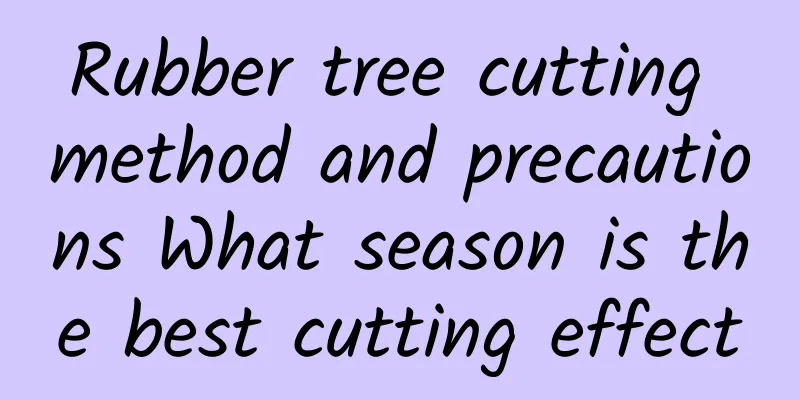Rubber tree cutting method and precautions What season is the best cutting effect

|
The leaves of the rubber tree are huge and dark in color. They not only have a strong decorative effect, but also can purify the air and absorb dust. They are very suitable for home green plant cultivation. When planting rubber trees, many people want to use cuttings for propagation. The following is a detailed introduction to the rubber tree cutting method. Rubber tree cutting method1. Cutting time Rubber trees can be grafted in spring, summer and autumn, but June and July are better . The air humidity is high at this time, which is suitable for the growth of rubber trees. 2. Cutting selection Rubber tree branches and tender branches can be used for cuttings. Select branches that are more than 10 cm high, cut an oblique cut at the bottom, rinse the white liquid from the wound with clean water, put carbendazim at the bottom of the wound, and put the whole branch in a cool and ventilated place to dry. Generally, it takes 3 to 5 days to dry the wound until the bottom of the wound turns white and dry. It can also be used for flower arrangement. 3. Pot soil requirements To propagate rubber trees, you need to choose a suitable pot and prepare soil with good air permeability. Generally, the ratio of nutrient soil to nutrient soil is 1:1, so that the soil is breathable and water-permeable and contains nutrients. Or you can prepare leaf mold, fine sand, and garden soil, mix them in a ratio of 2:3:5, and then add decomposed farmyard manure as the culture soil. 4. Cutting method In the cultivation site, use a thin wooden stick to poke a few holes in the soil with a spacing of 3-4 cm. Insert the rubber tree into the holes, tighten them around, and water them thoroughly. Don't forget to add some rooting liquid or carbendazim when watering to promote rapid root growth and prevent root rot. Precautions for cuttings of rubber trees1. Fertilization In order for the rubber tree to grow well, it is necessary to strengthen fertilization management, apply nitrogen fertilizer 2 to 3 times a month, stop using nitrogen fertilizer in September, and apply phosphorus and potassium fertilizer to improve the plant's cold resistance. Rubber trees are dormant in winter, so fertilization should be stopped. 2. Watering Rubber trees like a moist soil environment. During the growth period, add enough water to keep the soil in the pot moist. Pay attention to controlling watering in winter to prevent root rot. 3. Pruning During spring pruning, remove the bifurcated branches, inward branches, dead branches and weak branches in the canopy, and cut short the protruding crown to keep the plant ventilated and light-permeable. If the crown is too large, the outer branches can be cut short as a whole. During the growth period, the overcrowded branches and short branches should be removed in time. 4. Replace the potting soil The plant needs to be repotted every spring. Adult plants are usually repotted every 2-3 years. When repotting, add more fertilizer and soil. |
<<: How to plant radish? Steps and simple methods of planting radish and cultivation techniques
Recommend
How many years does Moringa bear fruit?
Introduction to Planting Moringa The minimum temp...
When is the best time to prune cloud bamboo?
The role of cloud bamboo pruning The branches and...
What plants should be placed in the living room to bring wealth and good health to the whole family?
1. Lucky Bamboo Lucky bamboo itself is very beaut...
Cultivation methods and precautions of fuchsia
1. Breeding methods 1. Temperature: It is best to...
Is the yield of mangosteen high? What is the yield per mu?
Is the yield of mangosteen high? The yield of man...
Is it better to use a large or small pot for potted yellow jasmine?
Should I use a large or small pot for potted yell...
How to deal with Anthurium after flowering
1. How long is the flowering period? It belongs t...
What to do if daffodil roots rot
1. Treatment of soil-cultured root rot 1. Trim of...
What to do if the leaves of Clivia are very thin
1. Insufficient light There is an old saying that...
How to pinch the tip of Liubeili
Six times profit topping requirements In the actu...
How to prepare homemade nutrient soil (super simple method to make nutrient soil for growing flowers)
Flower-growing "universal soil" mother ...
What are the cultivation methods and precautions of the boss tree?
How to cultivate the Laoshuang tree The origin of...
What are the cultivation methods and precautions of purple spider plant
Purple spider plant Purple spider plant, also kno...
Aromatherapy Benefits of Lavender Essential Oil
1. Helps you sleep Lavender essential oil aromath...
How to fertilize Croton
1. Fertilization after layering propagation Croto...









